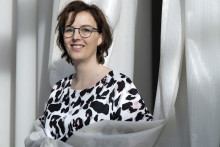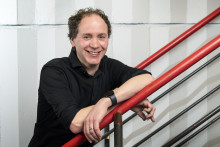‘I have always been passionate about nature and this beautiful planet,’ says Lysanne Mol. Yet, the PhD candidate never imagined that it’d become part of her career. She studied Biomedical Engineering and assumed she’d work on health applications, such as disease detection.
Until she came across a research topic that combined both: health and the environment. ‘Before, I didn’t see the overlap of environmental research and health research – which seems kind of obvious now. Of course, the environment impacts our health. We live in it.’
lysanne mol
PhD research topic: The development of a dynamic lung-on-chip model with biomimetic hydrogel for assessing the translocation and toxicity of micro- and nanoplastics
Work: PhD candidate at the Applied Microfluidics for BioEngineering Research (AMBER) group, Faculty of Electrical Engineering, Mathematics and Computer Science (EEMCS) at the University of Twente
Education: Biomedical Engineering at the University of Twente
Originally from: Harderwijk, The Netherlands
Plastics in our blood
The UT researcher is developing a lung-on-a-chip that should allow us to accurately test the effects of microplastics and nanoplastics on human health. ‘Microplastics and nanoplastics are tiny pieces of plastic that originate from regular plastics we use every day,’ explains Mol. ‘They are everywhere - in our drinking water, in the air; researchers even found them in our blood.’
Although we know that we can’t avoid coming into contact with these plastics, what we don’t know is: are they dangerous to us? And if so, how much? ‘At this point, we know very little about their effects,’ says Mol. This poses a serious risk. ‘We all inhale them. We can’t avoid it, whether we are inside or outside. If we know what their effects are, we know what we should change. If they turn out to be harmless, it’s less urgent to deal with this issue. However, if they turn out to be very dangerous, we have to stop using the materials, or find a way to prevent micro- and nanoplastics from releasing into the environment.’
This would not be the first time a common material would have to be banned, points out the PhD candidate. ‘It has happened before. Asbestos was widely used for building insulation, but it turned out to be very dangerous for our lungs. The same could be true for some plastics. That is the big challenge, though. There are so many different types of plastics out there, all with different shapes and structures. It is therefore likely that only some of them are harmful.’
Lung-on-a-chip
Scientists are trying to find answers to these questions but, as Lysanne Mol points out, most studies have used animal models or traditional cell culture models, which are not necessarily accurate. ‘We haven’t drawn a clear picture yet.’
This is precisely why Lysanne Mol is working on a lung-on-a-chip, a device that essentially aims to recreate the environment inside the human body. ‘If cells can behave the same as they would inside human lungs, we can test the effects of these plastics much more accurately,’ she explains.
‘The device is very small, about the size of a coin,’ describes the researcher. ‘Inside it we create micrometer channels, so that we can create flow like there’d be inside a blood vessel, for example. Because we work with ‘lungs’, we also aim to create a stretching – breathing – motion to mimic the environment of a real lung. The device contains a hydrogel, on which the cells grow, and medium channels to feed the cells, as well as access to air which lung cells need. In later stages, we will add microplastics and nanoplastics directly to the air to test how the cells react to them.’
‘Doing a PhD was not a given for me' - Lysanne Mol
If successful, the lung-on-a-chip could have other benefits than ‘only’ testing the effects of micro- and nanoplastics. Like other organ-on-a-chip devices, it could serve as an alternative to animal testing. ‘I’m not sure if it will completely replace animal testing, but it can certainly offer an additional model, and therefore reduce animal cruelty which is very important,’ says Mol.
‘Moreover, if we can predict effects of potential toxins or the effectiveness of medication better, clinical testing on humans could become much faster, more efficient, and safer. If you can eliminate some failed clinical trials, you can save a lot of time and money.’
Making a difference
These possible improvements – to both human health and the environment – drive Mol’s research forward. ‘Doing a PhD was not a given for me. It was this specific topic that got me to stay,’ she says. ‘Every time I feel a bit discouraged, I think about the amazing connection between the environment and health, and it really motivates me.’
She hopes her doctoral research and findings will make a real difference one day. ‘I hope that we manage to find an answer to this very difficult question – of how microplastics and nanoplastics impact our health,’ says Lysanne Mol. ‘But most of all, I hope that this answer will not just stay inside the scientific community. I hope it will get to politicians and policy makers and that, if needed, we actually work towards a solution together.’








